Iowa is located in the Midwestern region of the United States. It has a vast array of habitats but is particularly well known for its river borders, the most famous of which is the Mississippi River, which borders its east side. Although many different animals live in Iowa, snakes are particularly abundant throughout the state. There are 28 species of snakes in Iowa, of which four are venomous. Snakes can come in a variety of different colors, but many of Iowa’s snakes are black or have noticeable black markings. So let’s discover some of the black snakes in Iowa, including how to identify them and which ones to stay away from.
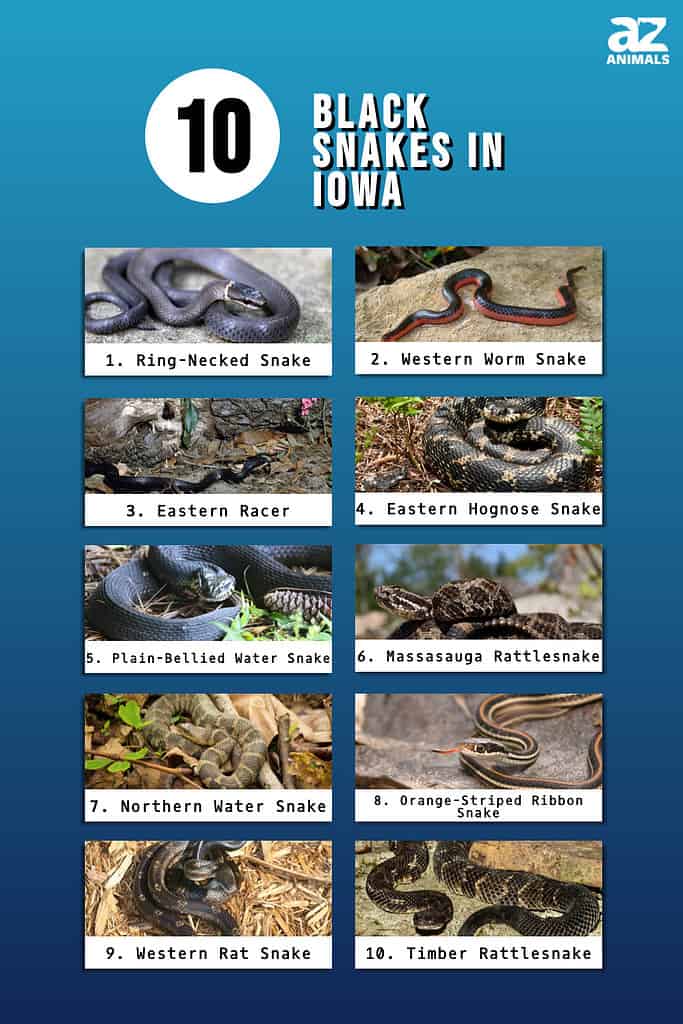
1. Ring-Necked Snake (Diadophis punctatus)
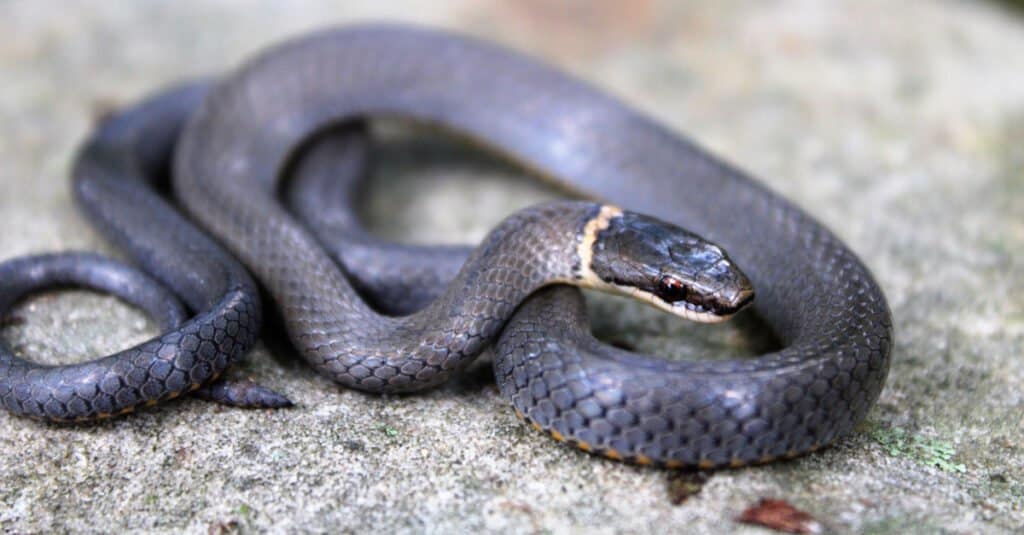
Ring-necked snakes mainly live in forested regions or near rocky hillsides.
©Tucker Heptinstall/Shutterstock.com
We’ll start the list with a small but colorful snake: the ring-necked snake, which is only 10 to 20 inches long. Ring-necked snakes are typically black with a brightly colored ring of red, yellow, or orange around their neck. Sometimes their bellies are the same color as their neck ring, but they are typically always dark on their upper side. Ring-necked snakes mainly live in forested regions or near rocky hillsides. Although they contain a mild venom produced in the Durvenoy gland, they are not harmful to humans. Ring-necked snakes are quick movers and are particularly secretive, so it might be difficult to spot one. However, they are widespread across the majority of Iowa, except the north-central region.
2. Western Worm Snake (Carphophis vermis)
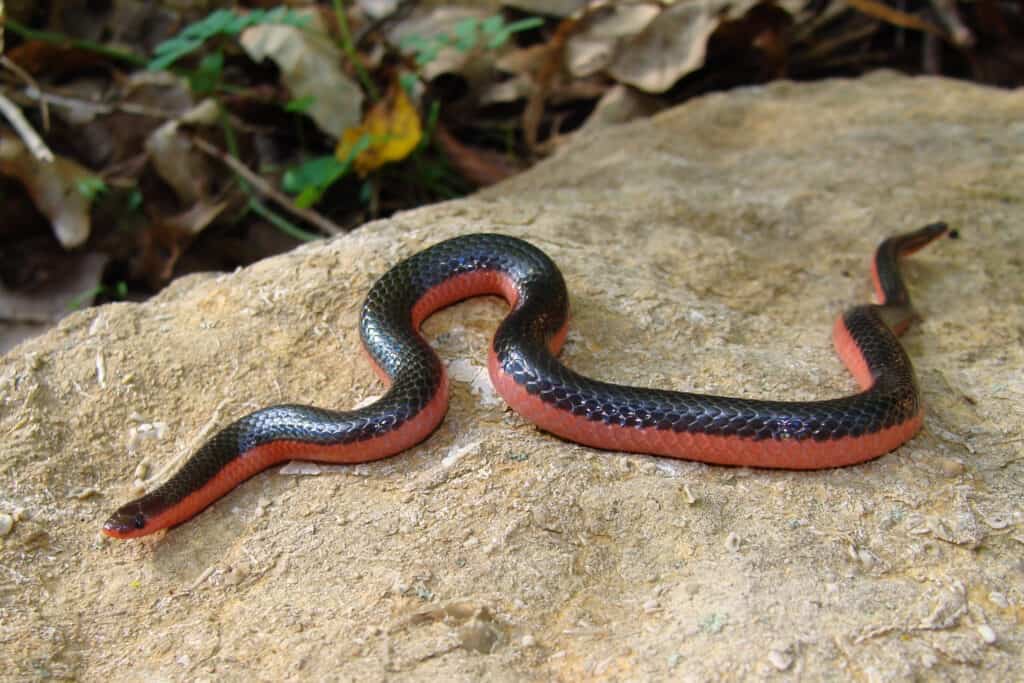
Western worm snakes prefer to live on rocky hillsides, where they spend their time hidden in the loose, sandy soil.
©Matt Jeppson/Shutterstock.com
Another black snake in Iowa is the western worm snake, which looks similar to the ring-necked snake, albeit smaller. Western worm snakes are black or purplish-black on their dorsal side with a lighter, reddish-colored belly. They have slender bodies and are typically 7.5 to 11 inches long. Western worm snakes prey primarily on soft-bodies animals such as earthworms. They are not venomous, but if threatened, they release a foul-smelling musk. Western worm snakes prefer to live on rocky hillsides, where they spend most of their time hidden in the loose, sandy soil or underneath rocks, logs, and leaf litter. In Iowa, they are restricted to only the southernmost regions of the state.
3. Eastern Racer (Coluber constrictor)

The eastern black racer is not venomous and, despite what its scientific name suggests, is not a constrictor.
©Weber/ via Getty Images
A snake with a reputation for being fast and agile is the eastern racer, which can often be seen with its head raised above the ground as it scans the surrounding area for predators or prey. Eastern racers are common across Iowa and live in a wide variety of habitats, including grassland, forests, prairies, and hillsides. Eastern racers are 20 to 60 inches long. Although there is some variation between the different subspecies, most are solid black or tan or dark dorsally with a lighter colored belly (of white, cream, or yellow). They are not venomous, and, despite what their scientific name suggests, they are not constrictors either. Instead, small prey are swallowed alive, while larger prey are simply subdued before being consumed.
4. Eastern Hognose Snake (Heterodon platirhinos)
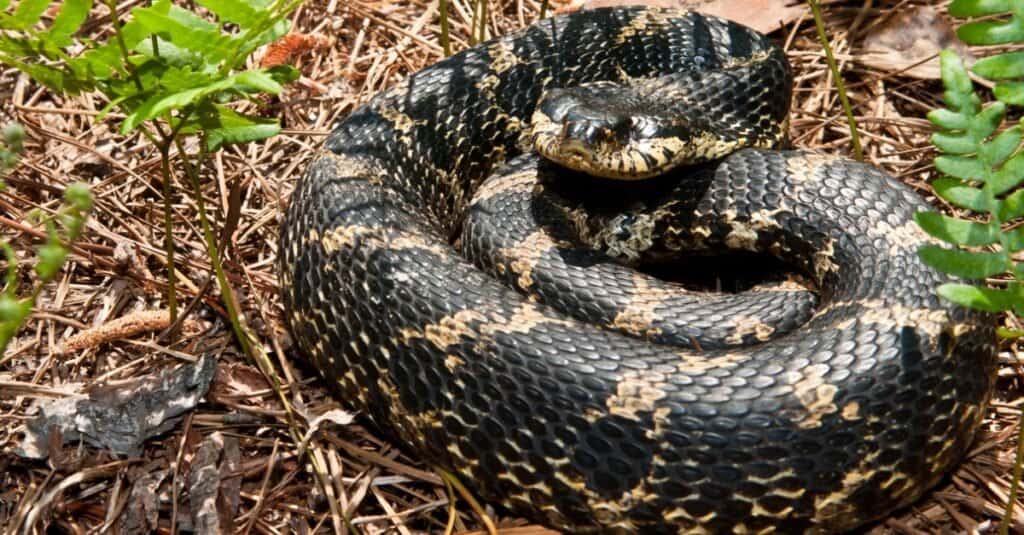
Eastern hognose snakes are found in the southern two-thirds of Iowa, where they prefer pine forests and forest edges with loose, sandy soil.
©iStock.com/JasonOndreicka
The eastern hognose snake is an unusual snake due to its distinctly upturned snout, which it uses to burrow into the soil with. Eastern hognose snakes are found in the southern two-thirds of Iowa, where they prefer pine forests and forest edges with loose, sandy soil. They average 28 inches long and can be black, brown, tan, grey, red, or orange but often have large, dark blotches on their dorsal side. Although eastern hognose snakes are also known as spreading adders, they are not considered to be venomous. Instead, they possess fangs at the back of their mouth, which they use to inject a very mild type of venom into their prey. They mainly prey on toads and are immune to their poison.
5. Plain-Bellied Water Snake (Nerodia erythrogaster)

Plain-bellied water snakes are usually 24 to 40 inches long and have thick, heavy bodies.
©iStock.com/lbolton09
A snake that is always found near a permanent water source is the plain-bellied water snake, which lives in scattered locations near the Mississippi River in Iowa. Plain-bellied water snakes are usually 24 to 40 inches long and have thick, heavy bodies. Their color can vary, but they are always dark colored — either black, brown, or grey with a plain, lighter-colored belly. Plain-bellied water snakes prey mainly on fish and amphibians.
6. Massasauga Rattlesnake (Sistrurus catenatus)

Massasaugas live in grasslands, woodlands, and near swamps and rivers.
©Ryan M. Bolton/Shutterstock.com
The first of two venomous black snakes in Iowa is the massasauga rattlesnake, an endangered species. Massasaugas are 24 to 30 inches long and are either tan or grey with large black or brown blotches across the middle of their back with smaller spots on their sides. Massasaugas live in grasslands, woodlands, and near swamps and rivers. Although they were once widespread across Iowa, they are now restricted to small populations in the southern areas of the state. Despite being secretive snakes, they are incredibly dangerous. They possess cytotoxic venom, which destroys the tissue and prevents blood from clotting. Therefore, you should always try to avoid them, but it is important to seek immediate medical attention if you are bitten.
7. Northern Water Snake (Nerodia sipedon)
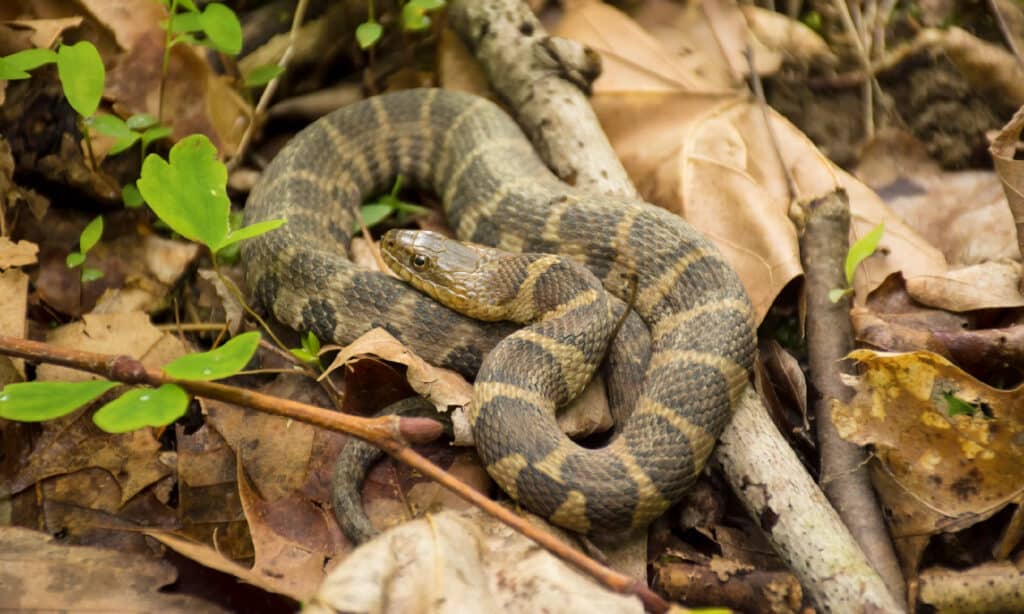
Northern water snakes are large snakes and can reach 54 inches long.
©iStock.com/IcemanJ
Another water snake in Iowa is the northern water snake, found in wetland habitats across most regions except the northwest counties. Northern water snakes are large snakes and can reach 54 inches long. They are usually brownish black with darker crossband markings on their neck and large blotches down their body. Although they are not venomous, northern water snakes are often mistaken for the venomous cottonmouth snake. However, if they are threatened, then they will readily bite. As their saliva contains a mild anticoagulant, any wounds can bleed a lot.
8. Orange-Striped Ribbon Snake (Thamnophis proximus proximus)
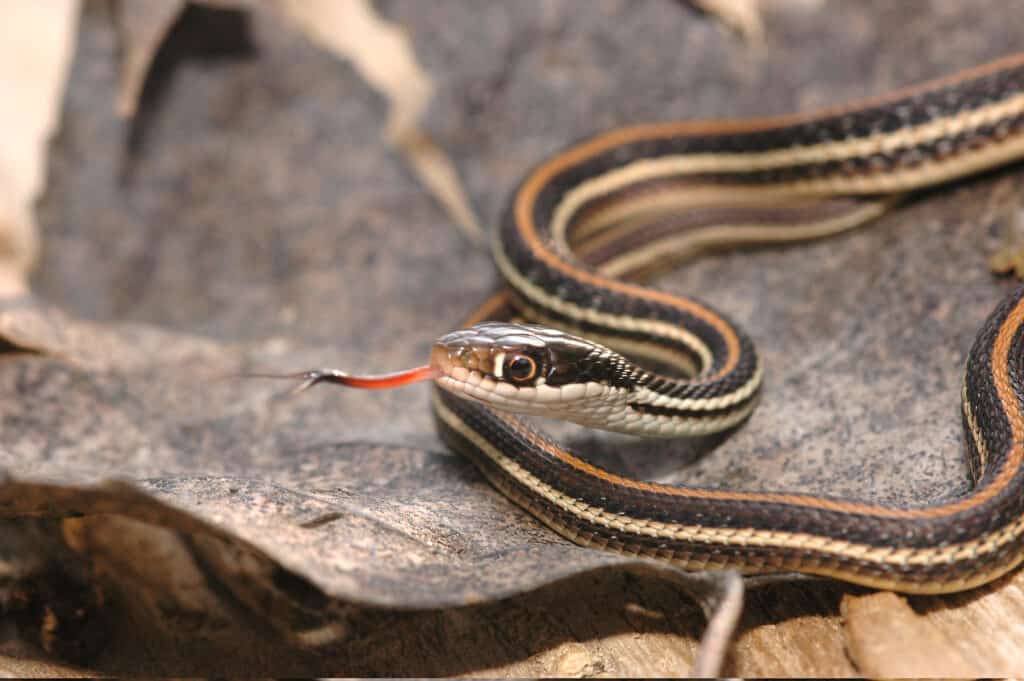
Orange-striped
ribbon snakes
are 20 to 30 inches long, and their tail makes up approximately one-third of their length.
©iStock.com/Shoemcfly
A subspecies of the western ribbon snake, the orange-striped ribbon snake is a slender snake with a long tail. Orange-striped ribbon snakes are 20 to 30 inches long, and their tail makes up approximately one-third of their length. They are black with yellow or orange stripes down their back and sides. Their belly is sometimes cream, and they usually have either an orange or yellow spot on the back of their head. Orange-striped ribbon snakes often live near water, such as streams, rivers, swamps, and ditches. They are agile snakes and often move quickly, if disturbed, into the water. However, they are only found in the southern half of Iowa.
9. Western Rat Snake (Pantherophis obseletus)
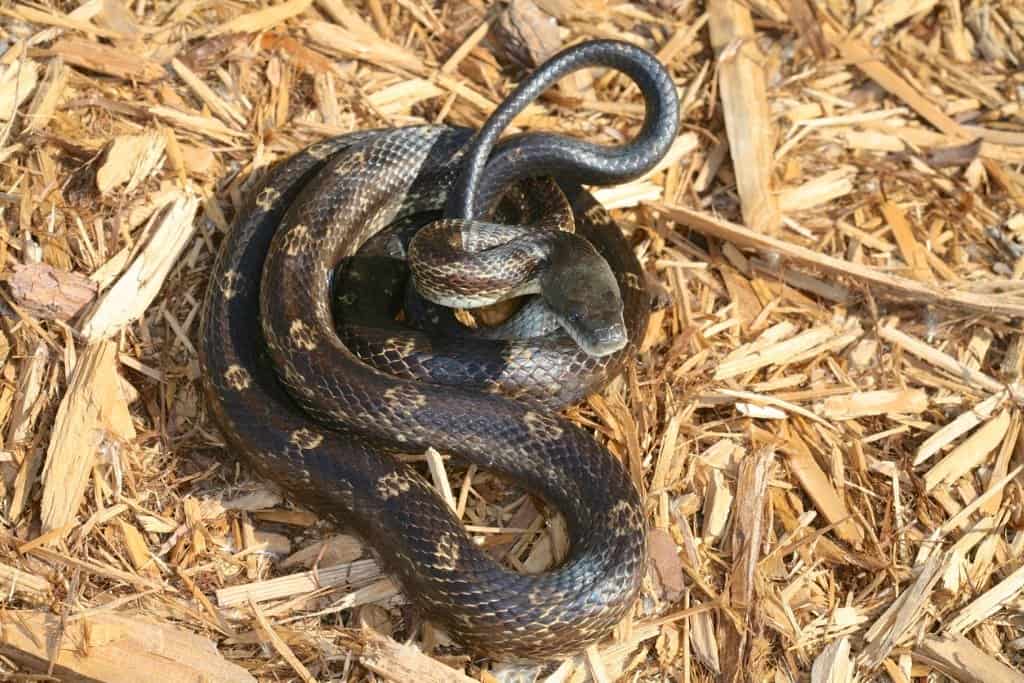
Western
rat
snakes darken as they mature and lose most of the pattern on their heads and bodies.
©iStock.com/Naja Shots
Also known as the black rat snake, the western rat snake has a glossy black appearance with distinctive white patches on its chin, throat, and lips. They are large snakes and can reach lengths of up to 6 feet. Western rat snakes are constrictors and kill by squeezing their prey. They are actually beneficial snakes as they prey on many pests such as rodents. Western rat snakes live in a wide range of habitats including rocky outcrops, prairies, woodlands, and grasslands. However, in Iowa, they prefer bluffs and forests along the Mississippi River. During the winter, they share dens with venomous snakes such as timber rattlesnakes and copperheads.
10. Timber Rattlesnake (Crotalus horridus)
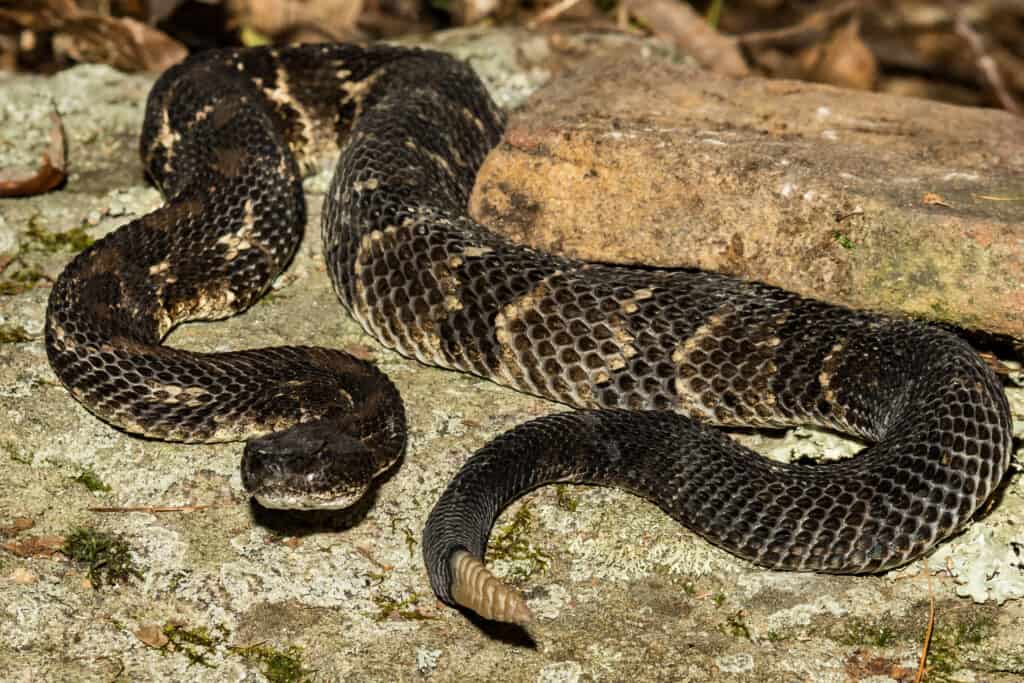
Black-phase timber
rattlesnakes
have dark speckles all over their bodies, making them look much darker.
©iStock.com/JasonOndreicka
The final black snake in Iowa is another venomous snake: the timber rattlesnake. Timber rattlesnakes live in forests and bluffs with rocky outcrops in the state. They are a protected species in 14 Iowa counties unless found within 50 yards of an occupied house. Timber rattlesnakes are approximately 5 feet long and usually brown with dark brown or black crossband markings. However, there are two different color morphs, one of which is the black phase. In this case, the snakes can appear to be almost entirely black as they have dark markings on a dark background color. Although they are not naturally aggressive and don’t readily strike without reason, timber rattlesnakes are incredibly dangerous, and care should be taken to avoid them.
Summary of 10 Black Snakes in Iowa
Here’s a recap of the 10 black snakes we took a look at that are present in Iowa.
| Number | Snake | Scientific Name | Range in Iowa |
|---|---|---|---|
| 1 | Ring-Necked Snake | Diadophis punctatus | Widespread across the majority of Iowa, except north-central region |
| 2 | Western Worm Snake | Carphophis vermis | Only in the state’s southernmost regions |
| 3 | Eastern Racer | Coluber constrictor | Common across Iowa in a variety of habitats |
| 4 | Eastern Hognose Snake | Heterodon platirhinos | Southern two-thirds of the state |
| 5 | Plain-Bellied Water Snake | Nerodia erythrogaster | Scattered locations near the Mississippi River in Iowa |
| 6 | Massasauga Rattlesnake | Sistrurus catenatus | Once widespread across Iowa, now restricted to small populations in the state’s southern areas |
| 7 | Northern Water Snake | Nerodia sipedon | Wetland habitats across most regions except northwest counties |
| 8 | Orange-Striped Ribbon Snake | Thamnophis proximus proximus | Only found in the southern half of Iowa |
| 9 | Western Rat Snake | Pantherophis obseletus | Bluffs and forests along the Mississippi River |
| 10 | Timber Rattlesnake | Crotalus horridus | Forests and bluffs with rocky outcrops in Iowa |
The photo featured at the top of this post is © iStock.com/RCKeller
Sources
- HerpNet.net, Available here: http://www.herpnet.net/Iowa-Herpetology/reptiles/snakes/eastern-massasauga-sistrurus-catenatus/
- HerpNet.net, Available here: http://www.herpnet.net/Iowa-Herpetology/reptiles/snakes/timber-rattlesnake-crotalus-horridus/
- HerpNet.net, Available here: http://www.herpnet.net/Iowa-Herpetology/reptiles/snakes/western-worm-snake-carphophis-vermis-2/
Thank you for reading! Have some feedback for us? Contact the AZ Animals editorial team.






